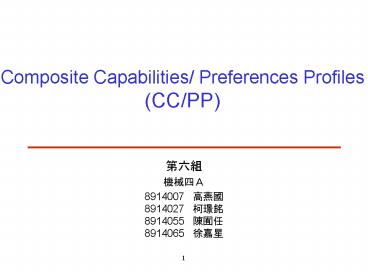Composite Capabilities Preferences Profiles CCPP PowerPoint PPT Presentation
1 / 16
Title: Composite Capabilities Preferences Profiles CCPP
1
Composite Capabilities/ Preferences Profiles
(CC/PP)
- ???
- ???A
- 8914007 ???8914027 ???8914055 ???8914065
???
2
Introduction
- CC/PP stands for Composite Capabilities/Preference
s Profile, and is a system for expressing device
capabilities and user preferences. - The goal of the CC/PP framework is to specify how
client devices express their capabilities and
preferences (the user agent profile) to the
server that originates content (the origin
server). The origin server uses the "user agent
profile" to produce and deliver content
appropriate to the client device. In addition to
computer-based client devices, particular
attention is being paid to other kinds of devices
such as mobile phones.
3
Devices
- The web is accessed by various devices
- PC, NoteBook, PDA, Mobile Phone
- Each one having different capabilities
- Hardwarescreen size/color, audio, bandwidth
- Softwarempeg, mp3, 3GPP, AMR
4
CC/PP RDF
- The CC/PP framework starts with RDF and then
overlays a CC/PP-defined set of semantics that
describe profiles. - CC/PP, RDF based profiler, is a collection of
information of capabilities of hardware platform
and system software, and preferences of the user.
5
Advantages of CC/PP
- By only sending required content, no time or
bandwidth is wasted sending unwanted content.
This can also lead to faster page loading times. - A server can provide information to a more
diverse range on browsers. This can not only be
beneficial in economic terms, but also in terms
of site accessibility. - You give the users what they want, not what you
think they want. - So many
6
Deployment(Client Server Proxies)
7
Deployment (Server Proxy only)
8
Deployment (Client Proxy only)
9
Deployment (Ideal Approach)
10
CC/PP Query
11
Content adaptation
12
Two ways to use CC/PP profiles
- Selection
- If the web server has a set of pre-written web
pages, suitable for a number of different
devices, then the profile can be used to decide
which of these pre-written pages is most suitable
for the web browser. - Transformation
- Web page content can be kept in a neutral format
(e.g. XML). This can then be transformed into an
appropriate format, using the profile to decide
what that format is.
13
CC/PP Implementations
- DICE
- Hewlett Packard
- DELI
- Intel
- Inria
- Keio University - Portal
- UMBC
- JIGSAW
- X-Smiles Browser
- So many
14
Demonstrations
- An example of RDF file and graph
- A Demo Page presenting the functionality of the
CC/PP protocol
15
Preferance
- http//www.w3c.org
- http//www.w3.org
- http//www.webstandards.org
- http//www.ccpp.org/
- http//dice.ccpp.info/
- http//www.tml.hut.fi/Opinnot/Tik-111.590/2000/Pap
ers/Rdf.html - http//castrato.ics.forth.gr/qh/
- http//www.csse.monash.edu.au/projects/MobileCompo
nents/projects/pda_doc_layout/seminar-html/
16
Thank you !!
- Q A

